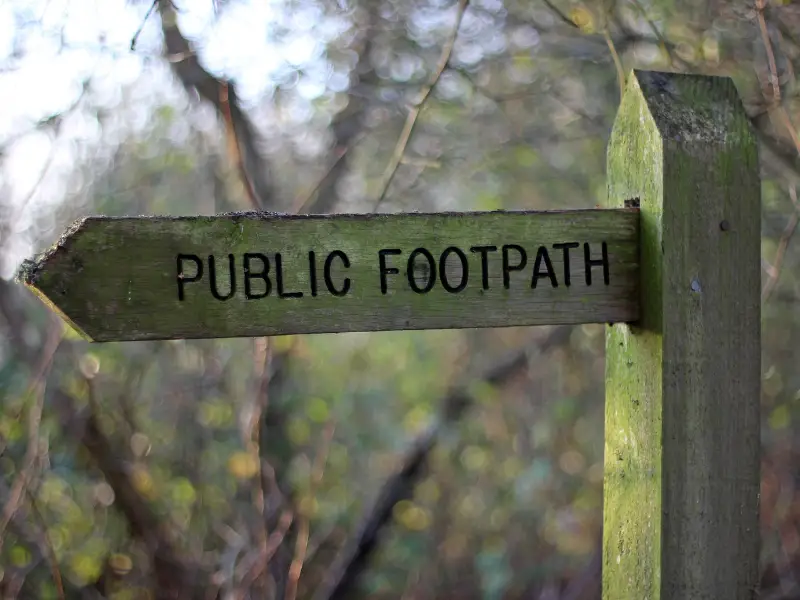Walking in the UK is something of a national obsession. It is beloved in spite of sometimes very changeable weather (looking at you Lake District). If you’re looking for a challenge from your next trip paired with panoramic views, quaint market towns and local history, then a walking tour holiday in the United Kingdom may be for you! This is the best way to really see the English countryside.
What Makes a Walking Holiday Great?
Public Access
Since 1949 a vast network of footpaths in England and Wales have been protected and preserved for public use. Very unlike hiking in the US, this means that you can even cross privately owned land on these public trails.
One of my favorite hobbies in any part of the UK is to find a public footpath sign and just see where it takes me. Sometimes it’s an alley shortcut between buildings and sometimes it’s across a farmer’s field full of grazing livestock. One stretch I stumbled upon took me down an alley between houses, around a churchyard, down a country lane, and across a field of cattle to the Thames.
It is important to remember that having access to these paths is a privilege and to be respectful of where you walk. Keep dogs on lead around grazing animals, close gates behind you, and don’t leave trash.
Mix of Wilderness and Civilization
The National Parks provide your longest stretches away from major roads and villages. Most paths will give you options for your hiking tour to include a stop at a country pub or a night spent in a hotel rather than a tent. If you want to camp your way along a whole route, you absolutely can make that happen. If you instead want to book accommodation with a shower and warm meal to end each day, that is also a possibility here.
How Hard are the Walks?
Keep in mind that while Americans talk about hikes, here an all-day trek will still be called a walk. Don’t let the word “walk” make you believe you’re only in for an easy stroll. You can absolutely take a relaxed pace on some trails, but you may also find a very strenuous path depending on your chosen location.
Most walks involve passing through gates or over stiles. A stile refers to a climbing apparatus placed so that you can cross a fence line. These may be a single step or a ladder. Some stiles have access gates next to them for dogs to pass through. Accessible paths can also be found – see the Miles Without Stiles resource further down.
Walks can stretch over days or weeks. While most are linear walks, you can find a circular route for a day trip or shorter walk. It is quite simple to adjust a walk around your available time and fitness level. Wherever you choose, keep time for admiring the beautiful landscape, watching the many animals you’ll encounter, and poking around local picturesque villages.
When to Visit
Most paths are open year-round, but some will have muddy conditions or even snow in the winter months. Late spring through summer provide your best months for fine weather and good trail conditions. In general, warmer weather will last longer the further south you are.
Backpack, Self Guided or Tour
There are three main categories for how people plan a walking holiday in England:
1. Backpack the whole trip and plan to camp along the way
This method is the least expensive as you won’t have to pay a guide or hotel accommodations along the way. This is best for experienced hikers who are comfortable setting up a camp and able to carry everything with them day in and out.
2. Take a guided walk
Guided walks are the most expensive, most luxurious, and least stressful option for a walking holiday. Your guide will make sure you stay on path and pre-book your accommodations. A good local guide can also teach you about the local history along the way. Local guides will also often arrange for your luggage to be transferred from the start to finish point of each day’s walk so you will only need to carry a day bag while walking. This can be a much better way to experience the walk if you are not accustomed to carrying a full pack with you.
3. Self guided walk + luggage transfer
This middle option means that you will still walk on your own guidance and at your own pace but have a bit more luxury than backpacking affords. Luggage transfer companies can be booked independently to pick up your bags each day from your hotel or B&B and deliver them to your next stop. You will have to make sure you can get to your destination each day but can feel free to slow down when something catches your attention during the day. Luggage transfers can be a game changer in how far you are able to walk comfortably each day.
Dog Friendly Walking Holiday
A walking holiday can be an ideal trip to share with your four-legged friend. Dogs are welcome in many restaurants and hotels (but be sure to check ahead of booking). If you want help finding dog friendly places on your route, several walking holiday booking agents provide specific help with this type of booking.
Where to go
From the Lake District to the Yorkshire Dales National Park to Hadrian’s Wall, there are many famous and famously beautiful places to be found walking across Great Britain. Here are some of the very best walks that England has to offer.
Cotswold Way
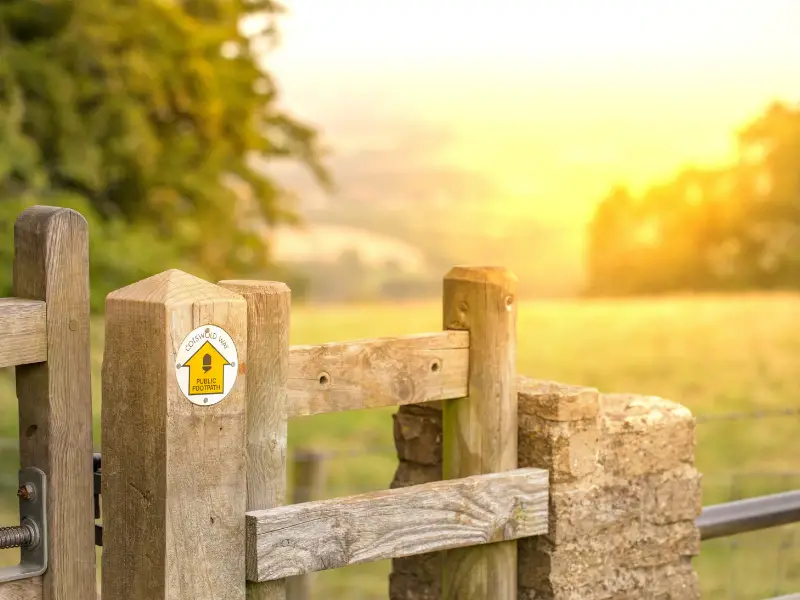
This walk travels 102 miles from Chipping Camden to Bath. The whole route can be completed in 10 days. The walk crosses around some of the prettiest areas of England and includes what most people tend to envision when they think of a quaint English village.
Besides picturesque English villages, history is also very present on this walk. It features Neolithic barrows, beautiful old homes, and the famous Roman baths in Bath.
South West Coast Path

England’s longest national trail, the South West Coast Path stretches a staggering 630 miles along beautiful coastal cliffs and sandy beaches. To complete this whole walk in one walking holiday will take you 52 days. It was recently included in National Geographic’s 100 Hikes of a Lifetime.
Along the way, you can see legendary castles and many charming port towns. The trail also passes along the Jurassic Coast, a UNESCO recognized site known for being a rich heritage site for prehistoric remains.
South Downs Way

The South Downs Way is unique in that all 100 miles of it are within the South Downs National Park. The full walk can be completed in 9 days. While it is fully inside a national park, this walk is also easily accessible from London and provides many opportunities to be back in civilization within minutes.
The walk is a mix of rolling countryside and coastal views. The chalk cliffs of the Seven Sisters are included along the walk and make for a dramatic sight. The whole path is a place of natural beauty that makes you forget how quickly you arrived there.
For a day walk in the South Downs National Park, see my guide to Halnaker Windmill and the ancient Roman tree tunnel road.
Hadrian’s Wall Path
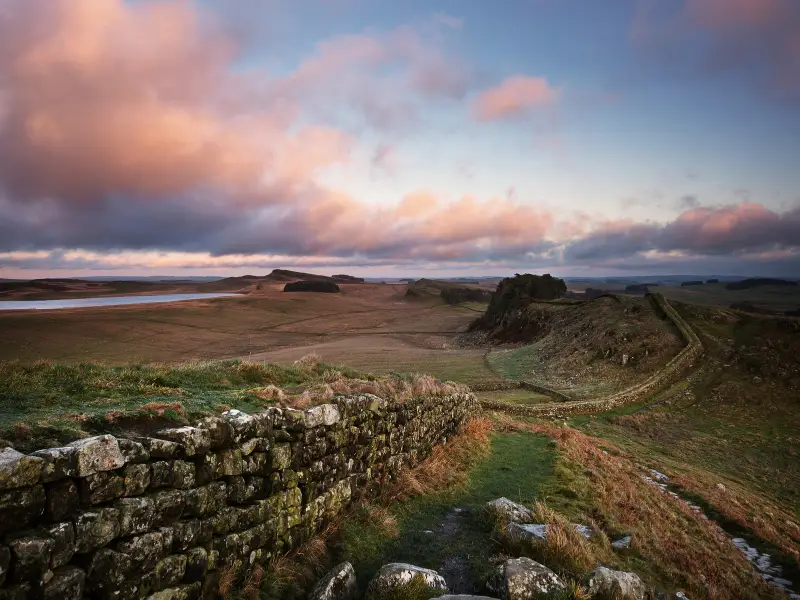
At only 84 miles long, this walk is a bit shorter than some of the others mentioned here and can be completed in 7 days. The walk follows Hadrian’s Wall, which was built by the Romans in the 2nd century AD along the Scottish border. The entire trail follows this UNESCO World Heritage Site. This walk will take you from coast to coast across the narrowest part of England near the border of Scotland.
Cleveland Way
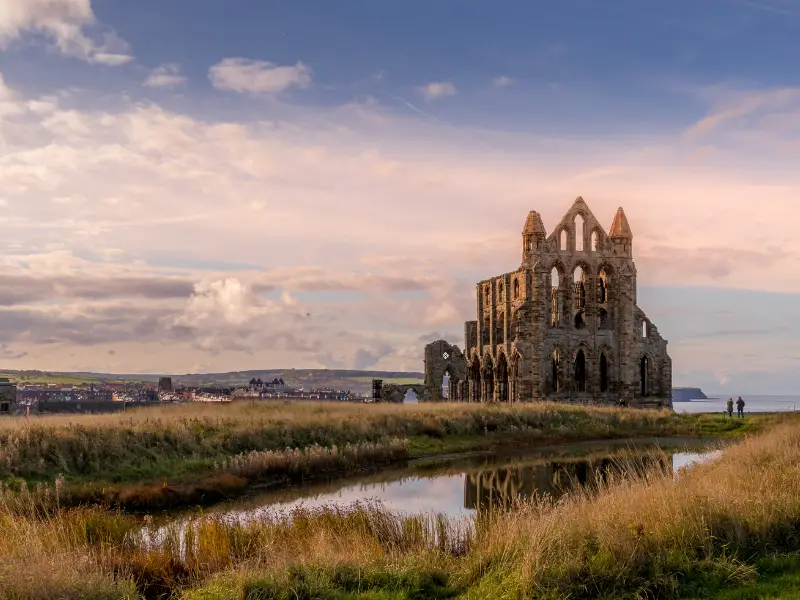
This walk travels 109 miles and crosses the North York Moors National Park and travels along cliffsides on the eastern coast of England. The entire route can be completed in 9 days and takes in a variety of landscapes. Highlights along the route include Whitby Abbey, which inspired Bram Stoker’s Dracula.
Pennine Way
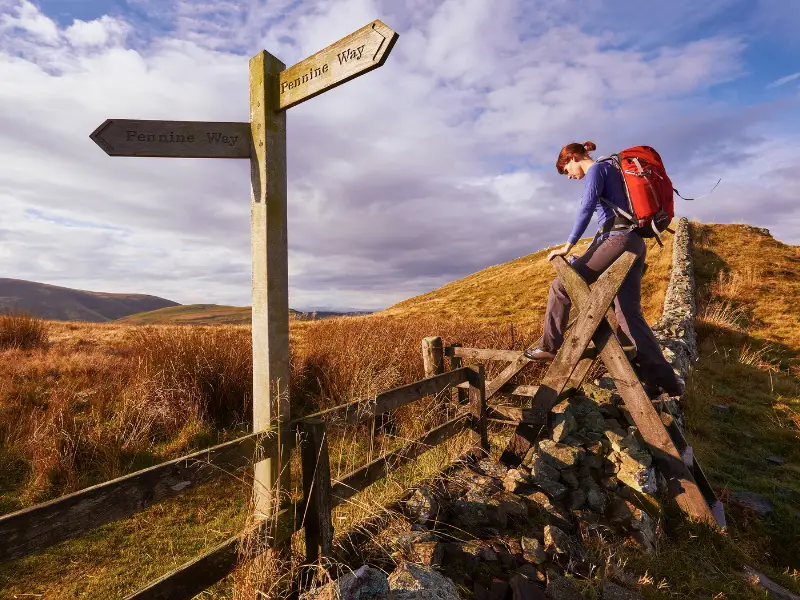
The Pennine Way is the oldest national trail in England, and is the most rigorous. This is not a gentle walk, but if you are looking for a physical challenge and the chance to get furthest from civilization, then this path is for you.
This path is also important to the history of walking in England. The walk includes Kinder Scout. This was the site of the 1932 Mass Trespass, which was pivotal to securing the public access to private lands that make all of these walks possible today.
Resources to Learn More
The National Trails website is very comprehensive. They can help you choose the best route for your walking holiday based on your available time, fitness level, and preferred theme.
The Don’t Lose Your Way campaign is currently working hard to properly document existing footpaths to ensure they stay open for future generations to enjoy.
Miles Without Stiles refers to walking paths with improved accessibility. Most of the national park websites include information on the paths within them. A good example from a much beloved area of England is this resource from the Lake District National Park.
Save this post to Pinterest for future reference!



